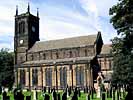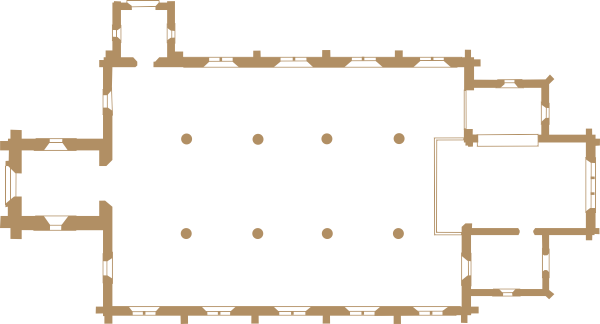For this church:    |
| |||||||||||||||||||||||||||||||||||||||||||||||||||||||||||||||||||||||||||||||||
Key to Glass |
Chancel
1.The East window
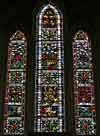 |
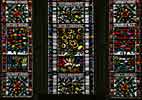 Detail Detail |
 Detail Detail |
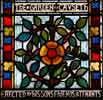 Detail Detail |
A memorial window to Francis Wright, one of the founders of Holy Trinity church.
The east window has three tall lights, the centre one being taller than the outer ones. They are separated by a pair of slender round shafts rising from the window sill and terminating with half capitals at the level of the springing point for the arches of the lower outer lights. It is a very colourful window with a profusion of brightly coloured images of fruit and flowers set within equally colourful borders. The text is spread over all three lights:
|
Biblical text: Isiah 61:11
South Aisle
2a.The 'Timothy Window'
 Timothy and Timothy and his mother |
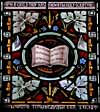 Open book Open book |
Memorial window to Thomas Adams, also known as the 'Timothy Window'.
This single light lancet window has three panels; the upper filling of the lancet shows a trefoil with two intertwined triangles surrounded by the text: 'Pater, Filius, Sp[irit]us S[an]c[tu]s.'
The centre panel depicts a young boy, Timothy, being instructed in the Scriptures by his mother and the lower an open book (on the pages of which are written 'All flesh is as grass, all the glory of man is as the flowers of grass') within a circle.
3.The Brewill memorial window
 |
 'Out of weakness 'Out of weakness were made strong' |
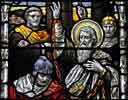 Detail of 'Of whom Detail of 'Of whomthe world is not worthy' |
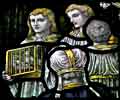 Detail of Detail of 'Obtained promises' |
This window consists of two tall lancet lights each divided into two scenes, one above the other. Ginever (1930) has provided a full description of the window:
'The subjects are suggested by Hebrews xi and are as follow:—
1.
Obtained Promises. The aged Simeon and Anna, the recipients of such gracious promises, welcoming the Christ-Child at His Presentation in the Temple. An ancient tradition states that the day of Christ's presentation in the earthly temple was the day of Simeon's presentation in the heavenly temple, and that his Nunc Dimittis was his swan song uttered just before his death.
2.
Out of Weakness were made Strong. Peter, after his denial and repentance, receives again his commission at the Sea of Galilee. Our Lord is bidding him "Feed my sheep, feed my lambs."
3.
Wrought Righteousness. Peter and John healing the impotent man at the Beautiful Gate of the Temple. Acts iii.
4.
Of whom the world was not worthy. Paul is here depicted preaching on the steps of the Castle of Antonia, having been rescued from the mob in the Temple of the Roman Governor and General, both of whom are seen in the background. He was for a while allowed to speak, but as soon as he mentions his mission to the heathen world, with one accord the maddened Jews exclaim: "Away with such a fellow from the earth, it is not fit that he should live." Acts xxii.'
The dedication is set along the bottom of the window:
|
Mr. Brewill owned a butcher’s shop in Nottingham, but originally started his business in Lenton. A maker’s mark is not visible.
4.Thomas Adams memorial window
 |
 The Pharisee and
the The Pharisee and
thePublican in the Temple |
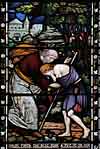 The return of The return of the Prodigal Son |
 The Good The GoodSamaritan |
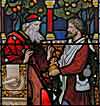 Detail of the Detail of the Faithful Steward |
A two tall two light window, the same style as the adjacent Window 3, with two upper and two lower scenes.
The window represents the proud Pharisee and the humble Publican in the Temple with the text 'God be merciful to the sinner' (Luke xviii); the Faithful Steward with the text 'Well done good and faithful servant' (Luke xix); the return of the Prodigal Son with the text 'Bring forth the best robe and put it on him' (Luke xv); and the Good Samaritan with the text 'Go and do you likewise' (Luke x).
The dedication at the bottom of the window reads:
|
5.Lois Ball Memorial Window
 |
 Visit of the Visit of theshepherds |
 The marriage The marriage feast at Cana |
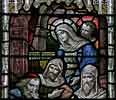 Detail of Christ Detail of Christin the Temple |
The same style as Window 3.
The window commemorates Mrs. Lois Ball and was provided by her sons, Mr. F. Ball (Mayor of Nottingham) and Alderman A. Ball. It was dedicated on 22 February 1914. According to the Nottingham Journal the window 'has four panels portraying events in the life of Christ which introduce the Mother of Our Lord. The first is the Annunciation (with the text 'Behold handmaiden of the lord'), the second the visit of the shepherds (with the text 'A saviour which is Christ the Lord'); the third, Christ in the Temple at 12 years of age (with the text 'All were astonished by His understanding'); and the fourth, the marriage feast at Cana (with the text 'Whatsoever he saith unto you do it').
The dedication along the bottom edge reads:
This window was erected to the Glory of God and to the memory of their loved Mother by her sons Frederick and Albert Ball 1914. |
A tall single lancet light, with glazing as Windows 6 and 7.
Tower
10.The West Window
The West window has three tall lancet lights with the centre light rising slightly above the outer two. The glazing is the squared Cathedral glass matching Windows 6 and 7.
As Window 9.
As Window 8.
North Porch
Set one on each of the west and east walls of the north porch, these two short single lancet headed lights are glazed with squared Cathedral glass.
North Aisle
A tall single light, matching Windows 6 and 7.
15.Lady Harriett Mary Ball Memorial Window
 |
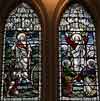 The Resurrection The Resurrection and the Ascension |
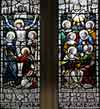 The Crucifixion and the The Crucifixion and the Outpouring of the Holy Ghost |
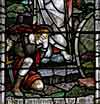 Detail of the Detail of the Crucifixion panel |
This window is similar in design to the windows in the south wall, having four panels. It was the gift of Sir Albert Ball in memory of his wife, Lady Harriett Ball, who died in March 1931 and who was buried in the family vault at the foot of the church tower. The window was dedicated on 10 January 1932 by the Bishop of Southwell, Dr H. Mosley, and was made by Heaton, Butler and Bayne of London. The upper left panel shows the Resurrection (with the text 'Now is Christ risen from the dead'), the upper right depicts the Ascension (with the text 'Ascend unto my Father and your Father'), the lower left panel shows the Crucifixion (with the text 'Father into thy hands cometh my spirit') and the lower right illustrates the Outpouring of the Holy Ghost on the day of Pentecost (with the text 'They were all filled with the Holy Spirit').
The inscription along the bottom edge of the window reads:
|
16.The Boer War Memorial
 |
 The soldier going The soldier going forth to battle |
 The soldier's The soldier'sreturn home |
 The soldier on The soldier on the watch |
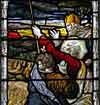 Detail of the Detail of theBattle of Rephidim panel |
This two light window has the same four panel design common to most of the church’s windows. It is a memorial to the 63 men of the parish who served in the Boer War with a special dedication to the seven men who did not return. The window was unveiled by Earl Roberts, V.C., K.G., Commander-in-Chief of the British Army, on 7 November, 1901 and is signed ‘Heaton, Butler and Bayne London’.
Reporting on Earl Roberts' visit to Nottingham, the Nottingham Evening Post, included a detailed description of the window design:
'The window is in four sections, and represents (1) the soldier going forth to battle, (2) the soldier on the watch, (3) the soldier in battle, and (4) the soldier’s return home. All the scenes are taken from Holy Scripture. The first (top, left hand) represents David going forth to battle, trusting in the righteousness of his cause, eschewing Saul's proferred armour (which lies at his feet), and going in reliance upon God. (1 Samuel xvii.) The second (top., right hand) represents Joshua making his sentry round by night in the vicinity of Jericho, and confronted by the Angel of the Lord, who undertakes the leadership of the host. (Joshua v.) The third (bottom, left hand) shows the host of Israel fighting against Amalek on the plain, while Moses, with Aaron and Hur supporting him intercedes on the Mount. (Exodus xvii.) The fourth represents David and Saul returning from their victories over the Philistines, and welcomed by the plaudits of the people. (1 Samuel xviii.) …. The window is the work of Messrs. Heaton, Butler and Bayne, artists in stained glass to His Majesty King Edward VII.'
Text upper left: 'David going forth to slay Goliath'
Text upper right: 'Joshua on the watch before Jericho'
Text lower left: 'The battle of Rephidim'
Text lower right: 'The return of David and Saul'
Across the bottom edge: 'DULCE ET DECORUM EST PRO PATRIA MORI' (It is a sweet and fitting thing to die for one’s country - from the Ode to Horace)
On the sill below the window is a long brass plaque with the names of the seven men who gave their lives:
ERECTED IN HONOUR OF 63 MEN WHO FROM THIS PARISH WENT FORTH TO THE SOUTH AFRICAN CAMPAIGN 1900-2,
|
|||||||||||||||
17.The Henry Kirk Memorial Window
 |
 The Good The Good Shepherd |
 The Good The GoodSamaritan |
 St Lawrence St Lawrence |
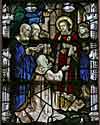 The Talents The Talents |
The same four panel style as the other memorial windows. The panels represent the Good Shepherd, the Good Samaritan, the Talents, and St. Lawrence, bearing the grid-iron, the instrument of his torture.
Henry Kirk left £500 to the National Schools.
The dedication along the bottom edge reads:
To the Glory of God and in Memory of Henry Kirk who died April 10th 1911 |
Above the west gallery is a large screen filling the west wall. It is half stained with the upper section and the arch filled with plain squared glazing set in lead strips. It transfers light from the large window in the west wall (Window 10) on the first floor of the tower.
In the west wall set high in the arch over the glass screen at the rear of the gallery are seven single lancet lights with the one in the centre the tallest and the three each side reducing in height to form a triangular arrangement. All are glazed with squared cathedral glass predominantly green/yellow in colour. Over the chancel arch a small single lancet light of the same design is located high in the apex.


